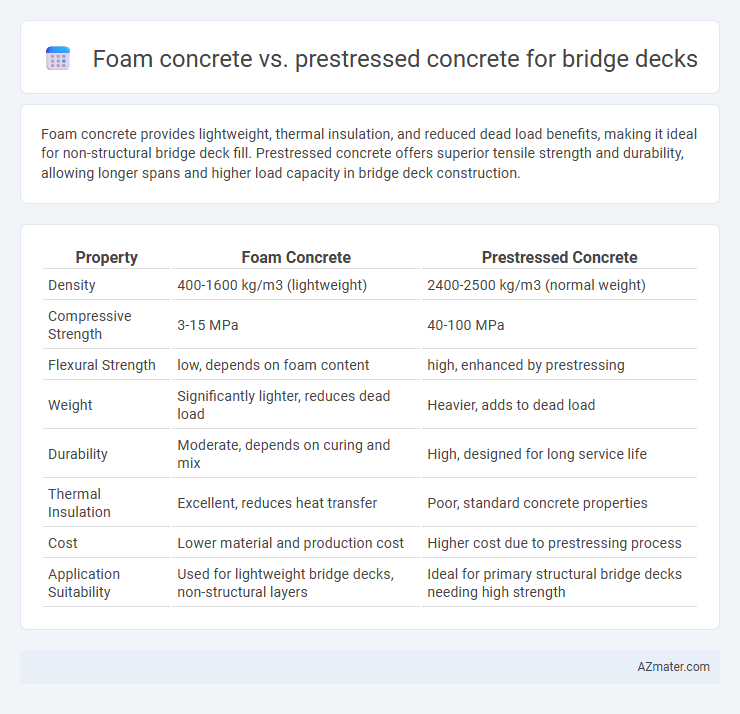Foam concrete provides lightweight, thermal insulation, and reduced dead load benefits, making it ideal for non-structural bridge deck fill. Prestressed concrete offers superior tensile strength and durability, allowing longer spans and higher load capacity in bridge deck construction.
Table of Comparison
| Property | Foam Concrete | Prestressed Concrete |
|---|---|---|
| Density | 400-1600 kg/m3 (lightweight) | 2400-2500 kg/m3 (normal weight) |
| Compressive Strength | 3-15 MPa | 40-100 MPa |
| Flexural Strength | low, depends on foam content | high, enhanced by prestressing |
| Weight | Significantly lighter, reduces dead load | Heavier, adds to dead load |
| Durability | Moderate, depends on curing and mix | High, designed for long service life |
| Thermal Insulation | Excellent, reduces heat transfer | Poor, standard concrete properties |
| Cost | Lower material and production cost | Higher cost due to prestressing process |
| Application Suitability | Used for lightweight bridge decks, non-structural layers | Ideal for primary structural bridge decks needing high strength |
Introduction to Bridge Deck Materials
Foam concrete offers lightweight properties and excellent thermal insulation, making it suitable for reducing dead load on bridge decks. Prestressed concrete provides enhanced strength and durability through the application of tensioned steel reinforcement, allowing for longer spans and greater load capacity. Selecting between foam concrete and prestressed concrete depends on factors such as structural requirements, cost efficiency, and environmental conditions.
Overview of Foam Concrete
Foam concrete is a lightweight, low-density material composed of cement, water, and stable air bubbles created by a foaming agent, offering excellent thermal insulation and reduced dead load on bridge decks. Its versatility allows for easy shaping and filling complex voids, making it ideal for non-structural or semi-structural applications in bridge decks where weight reduction and durability are critical. The material also exhibits good resistance to freeze-thaw cycles and chemical attacks, enhancing the service life of bridge decks in harsh environments.
Overview of Prestressed Concrete
Prestressed concrete in bridge decks involves pre-tensioning or post-tensioning steel tendons within the concrete to counteract tensile stresses, improving load-bearing capacity and reducing cracking. This method enhances durability and allows for longer spans with thinner slabs compared to traditional concrete types. It is especially advantageous in bridges requiring high strength-to-weight ratio and resistance to dynamic loads.
Key Material Properties Comparison
Foam concrete exhibits low density and high thermal insulation, with compressive strength typically ranging from 2 to 8 MPa, making it lightweight but less robust compared to prestressed concrete, which boasts compressive strengths exceeding 40 MPa and exceptional tensile capacity due to pre-applied tension in steel tendons. Prestressed concrete offers superior durability and resistance to cracking under dynamic loads, crucial for bridge deck applications subjected to heavy traffic and environmental stresses. Foam concrete's higher porosity results in lower modulus of elasticity and reduced load-bearing capacity, whereas prestressed concrete ensures enhanced structural performance with optimized stiffness and longevity.
Load-Bearing Capacity: Foam vs Prestressed Concrete
Prestressed concrete exhibits significantly higher load-bearing capacity compared to foam concrete, making it ideal for bridge decks requiring substantial structural strength and durability. Foam concrete, characterized by its lightweight and lower density, offers limited load-bearing capacity but excels in reducing dead load and providing thermal insulation. Choosing between foam and prestressed concrete depends on balancing the structural demands and weight considerations specific to the bridge design.
Durability and Longevity
Foam concrete exhibits excellent durability for bridge decks due to its lightweight nature and resistance to freeze-thaw cycles, reducing the risk of cracking over time. Prestressed concrete offers superior longevity by effectively managing tensile stresses, resulting in enhanced structural integrity and reduced maintenance requirements. Both materials provide durable solutions, but prestressed concrete generally ensures a longer service life under heavy load conditions and dynamic traffic stresses.
Construction Process and Installation Time
Foam concrete offers a lightweight solution with simplified placement through pumping or pouring, significantly reducing formwork and curing time compared to prestressed concrete. Prestressed concrete requires complex processes including tensioning steel tendons, specialized equipment, and longer curing periods, extending overall installation time. The quicker setting and reduced labor intensity of foam concrete make it ideal for expedited bridge deck construction projects.
Cost Analysis and Budget Considerations
Foam concrete offers significant cost savings over prestressed concrete for bridge decks due to lower material density and reduced formwork requirements, leading to lighter structures and decreased transportation expenses. Prestressed concrete, while more expensive upfront due to high-strength tendons and specialized labor, delivers enhanced durability and reduced maintenance costs over the bridge's lifespan, which can offset initial investments. Budget considerations must weigh the lower initial expenditure of foam concrete against the long-term economic benefits of prestressed concrete's structural performance and lifecycle cost efficiency.
Environmental Impact and Sustainability
Foam concrete significantly reduces environmental impact by incorporating lightweight, low-density materials that decrease cement usage and lower carbon emissions during production. Prestressed concrete, while offering superior strength and durability for bridge decks, typically requires higher cement content and energy-intensive manufacturing processes, resulting in a larger carbon footprint. Incorporating foam concrete in bridge decks enhances sustainability through resource efficiency and improved insulation properties, contributing to longer lifecycle performance with reduced environmental degradation.
Conclusion: Choosing the Right Material for Bridge Decks
Foam concrete offers lightweight properties and excellent thermal insulation, making it suitable for reducing dead load on bridge decks and improving energy efficiency. Prestressed concrete delivers superior strength and durability through pre-applied compressive stresses, enhancing load-carrying capacity and resistance to cracking. Selecting the right material depends on project-specific requirements such as load demands, environmental conditions, and cost constraints, with prestressed concrete favored for high-load, long-span bridges and foam concrete preferred for weight-sensitive applications.

Infographic: Foam concrete vs Prestressed concrete for Bridge deck
 azmater.com
azmater.com